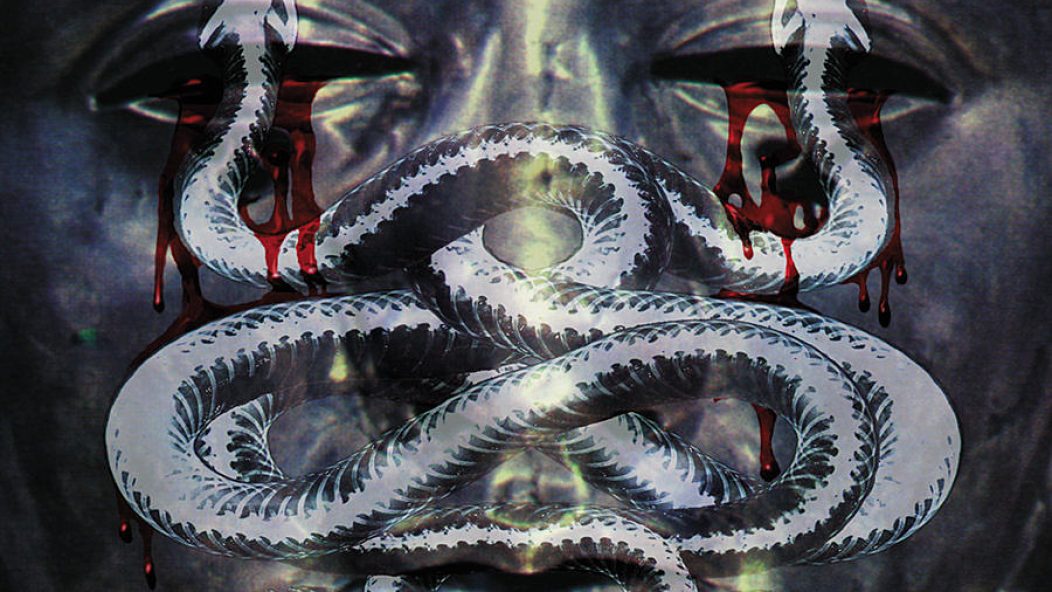
Neurosis - 'Through Silver in Blood' Turns 20
…
We’ve been covering Oakland’s seminal progressive sludge outfit Neurosis heavily as of late, in conjunction with the band’s 30th anniversary. Through Silver in Blood, their most popular and historic album, turns 20 tomorrow.
It’s the most iconic album Neurosis has made. The twin serpents of its cover grace the band’s collaboration t-shirt with Converge. Its lead single is their most-performed song (much more on that later).
Putting Through Silver in Blood in context presents a challenge. It doesn’t sound like much else on the market when it was released. Eyehategod comes closest, but Neurosis don’t share their blues roots or sneering poetry. The samples and chanting vocal delivery that characterize the album owe some debt to Godlfesh and bear some superficial resemblance to the first wave of rap metal of 1996, but Neurosis played with song length and form more than Godflesh, and as for rap metal, well, Korn used bagpipes too, but that’s where the buck ends. And while Through Silver in Blood does sound like a logical continuation of the last two Neurosis records, Souls at Zero and Enemy of the Sun, neither album approaches its darkness.
A better companion might be Metallica’s Master of Puppets. Each is an early career highlight by a bay area band tempering a juvenile style of music with arch seriousness. The bands’ respective fanbases love these albums with equal fervor, preach them like gospel. Master sharpens Ride the Lightning like Silver sharpens Enemy of the Sun, and both songs contain some of each band’s most memorable songs. The spectre of heroin haunts each album as well: Master’s flexible title track was, on inception, inspired by speedballs, and after all, what enters the body through silver and into the bloodstream?
But Metallica embody the gnosticism of classic metal. Neurosis are agnostic, not in terms of religious belief, but in terms of their relationship to the truth. Metallica fire accusations at society and at themselves on the basis that everyone, themselves included, deny the obvious truth of things—it is obvious that there is no god, it is obvious that society squashes individual agency. In contrast, Neurosis don’t settle on a single truth. The forces of the universe as heard in their music are unknowable. Metallica prize clarity. Neurosis obscure it, and 20 years later Through Silver in Blood remains opaque.
The advent of easy-to-use music editing software offers a modern visualization of music, one which may be more well-suited to Through Silver and Blood than the classic bass and treble clef: the loop. Cycles of bass and guitar notes, rather than playing in synchronicity, repeat, stop, and then repeat again, dogpiled overtop one another like some ur-stringed instrument, a precursor maybe to the eight-stringed guitars and subterranean tunings of today. All three vocalists in Neurosis shout one another down in the middle of the mix, varied slightly in pitch, not so much calling and responding as reacting, paranoid, to unseen events. When something approaches clarity, another sound emerges to obscure it—the epic album highlight ”Purify” reaches something like a tough groove in its second half until John Goff’s bagpipes join in.
Often these instructions are samples, and they dominate other sounds often, either as a repeated motif, like the feedback squeal in the title track, or on the cacophony of voices babbling about metaphysics on “Rehumanize” or the atomic bomb on “Become the Ocean,” the two interludes which roughly chop the album into three acts.
This dogpile of changing patterns combine to form the thick mud that is the album’s calling card. It’s to the credit of producer Billy Anderson that the album is listenable at all. Beneath the murk, each layer of sound is just transparent enough to allow a listener to focus on what’s underneath. Like the overlaid images on the album cover, Through Silver in Blood can be seen as a confusing whole or more sensible parts presented with distraction.
The murk clears for a moment, but even then Neurosis conceal meaning. Halfway through the tracklist at #5, and precisely halfway between the four song-long second arc of the album, at the Jungian plot climax, comes “Locust Star,” the closest thing to a hit single the band have. Through Silver in Blood’s lone period of true silence, a sixteenth note rest, precedes its first verse. A caesura, a cue, it signals: pay attention, this is important. “Locust Star” presents a big anthemic vocal hook, but one with indistinct wordplay as its focal point: Scott Kelly barks “Star reign down – on you,” but the “Reign” sounds like “rain.” That there’s an awkward pause right before “on you” only bends the hook more. The needlepoint of Silver is crooked, but that didn’t stop the song from getting a music video.
…
…
I prefer this live video of the band performing at Ozzfest after Through Silver in Blood came out. Their appearance hints at maybe someone wanting the derided fest to be something with progressive weight. Or maybe some record exec just got confused by the bagpipes. I have rarely seen such palpable (if performative) hatred and loathing in live footage. The expression on Kelly’s face while he screams “stick him” over and over suggests pathology. Look out for Noah Landis pummeling his keyboard with two balled fists. He looks as though he’s about to cry while people in the background mill about looking for cheap beer, unimpressed.
The members of Neurosis offer few insights. While they will play “Locust Star” and the title track, but rarely play anything else from the record (it’s been 9 years since they played “Purify”). Rarer is any communication on it. There’s no Decibel Hall of Fame entry for the band, and my guess is that an unwillingness to talk about Through Silver in Blood explains their absence. At this last Roadburn, Ian Cory told me that the band deflected questions about these songs during their Q&A. According to him, Steve Von Till said they would have to “burn the place down” in order to play any deep cuts.
In their defense, Through Silver in Blood sounds like a hard album to make. Its dense layering had to present a challenge in 1995 when it was recorded. Giving credence to that fact: the band did not make a record with Billy Anderson again; they chose instead to work with Steve Albini for all follow ups, none of which explore the thick murk of this record. If Neurosis cut metal’s timeline in half, and all post-metal follows them, then their own career is also bisected. We get Neurosis post-Through Silver in Blood. Their turning point remains as elusive, alluring, and challenging as it did when it was released.
…
…











